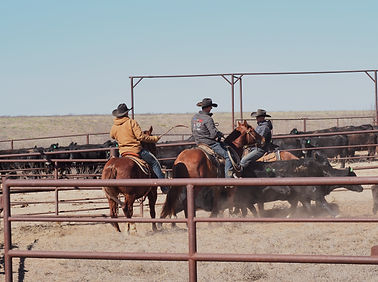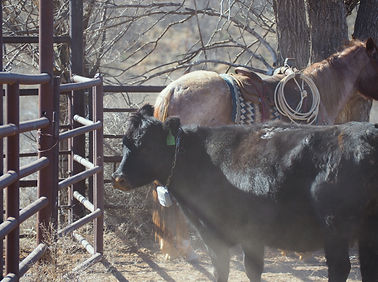MALLET RANCH MANAGEMENT COMPANY

Pasture and Cattle Management
Grasslands are shaped by a few key factors, not least among them being grazing. These prairies evolved alongside migrating herds of bison that would mow the prairies to the ground before moving on, stimulating new growth. Today we use cattle grazing as a management tool and manually move them from pasture to pasture across our ranch. But to successfully mimic the role of bison there is a lot more we have to consider...


Understanding Vegetation Limitations
Because we are manipulating grazing manually, we have to know exactly how far we can push the ecosystem we are taking from. We need to know exactly what kinds of plants are in a pasture, their nutritional content, and how many pounds per acre we have throughout the year.
In the photos to the left, you see part of how we get this information. We take randomized samples of the pasture and clip down all of the vegetation in a meter-by-meter square, then measure the dry weight. We can extrapolate that across the pasture to estimate how many pounds of forage we have per acre at the time of sampling.
Soils and Ecosites
Soil supports the growth of the grass we need, so we need to understand the soil to understand the limits to our potential to grow forage. The ranch has several ecosites, these are determined by how much sand, silt, and clay are in the soil, depth, how frequently it gets wet, etc. Some ecosites can grow more plants, while others grow less. Those that grow less grass, stock less cattle.


Cattle Distribution
It's vital that, along with rotating the cattle from one pasture to another, we also ensure that cattle are grazing the pasture they occupy as evenly as possible. For example: cattle spend more of their time closer to water sources, which means we need a working water well about every mile. If cattle don't graze the pasture evenly, one part of the pasture can become overgrazed leading to declining rangeland health. We regularly maintain our wells and drill any new ones we need to make sure the whole pasture is usable.
Virtual Fencing
We are presently under way with an experimental technology as an additional tool to move cattle about a pasture and keep them consuming the grass evenly. This virtual fencing works by deploying GPS shock collars on cows and reception towers. We use a computer to program a virtual boundary in by GPS, and the collars will begin to make a loud noise as the cow approaches the boundary. The collar will deliver an electric shock once the cow reaches the boundary, which discourages them from crossing it. Cattle rarely need to be shocked more than twice before they learn to respond to the noise.
To the right and below, you can see the process it took to secure them to the cattle, what the collars look like, and what the reception towers look like which maintain the virtual boundaries.



